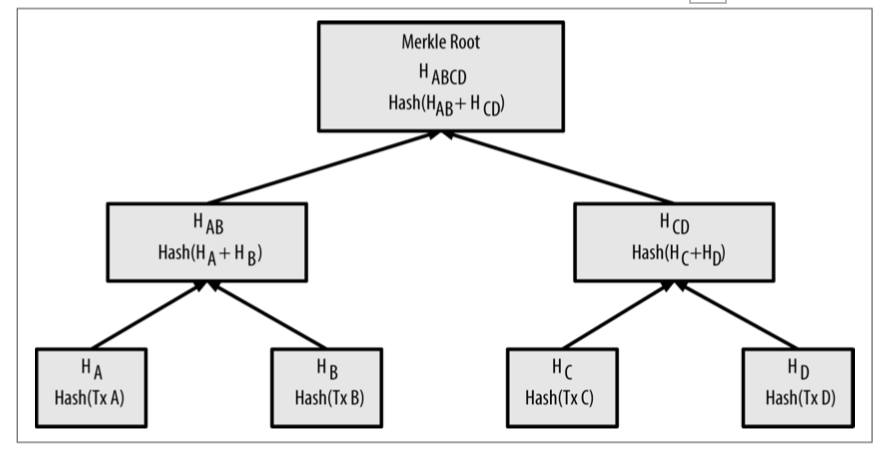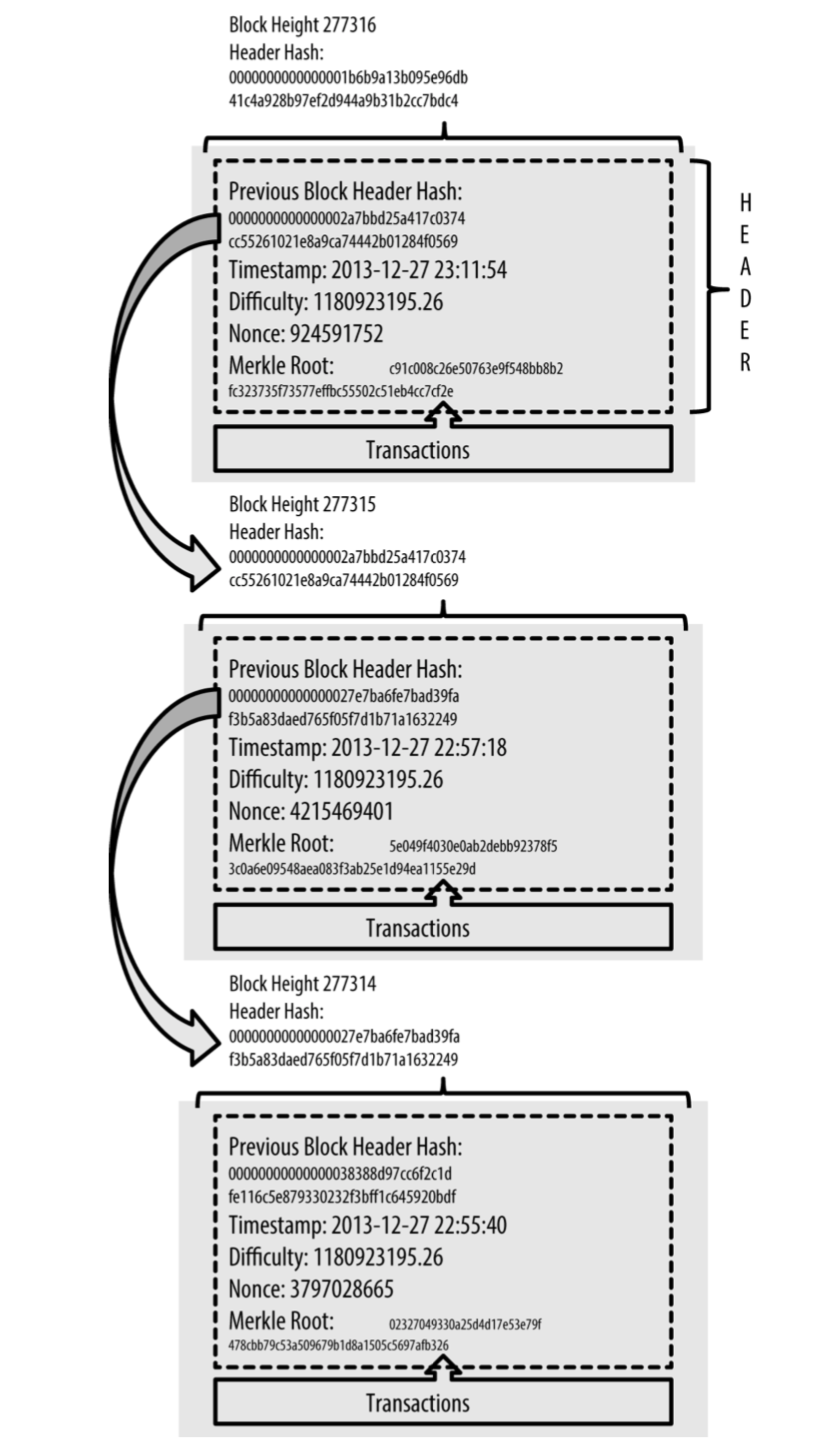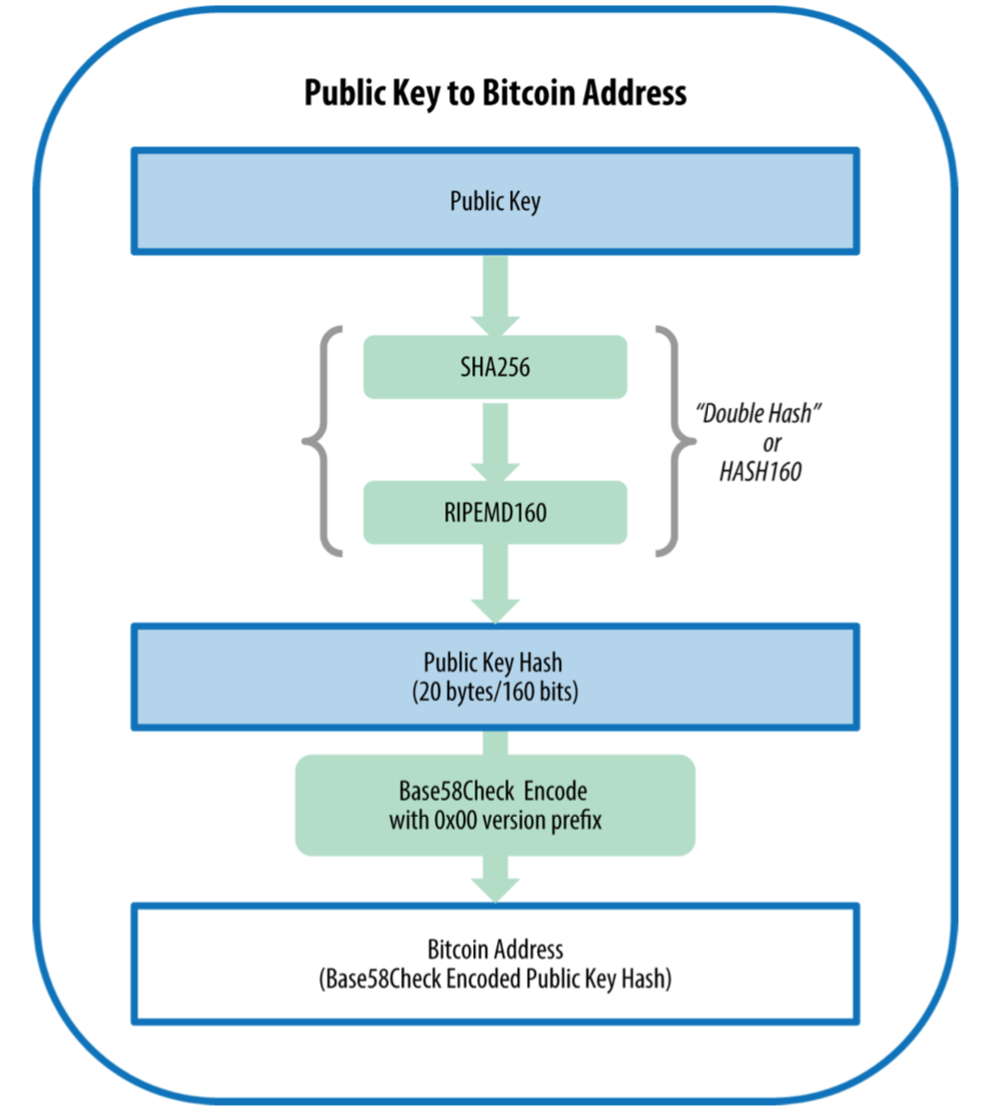區塊鏈學習1.4-比特幣原始碼的學習-比特幣基礎
1.3就已經提到區塊鏈的四大技術組合,我認為還是有必要了解背後的原理的。下面做一個簡要的介紹。
一. 區塊鏈資料結構和數字簽名演算法
1.資料結構Merkel樹
說到merkle樹就不得不談到交易,merkle樹就是用於存放交易的 資料結構。如下圖:

它是一個雜湊二叉樹,雜湊的過程如上圖所示。merkleroot表示整條鏈的交易摘要雜湊值。
其中一個區塊包含的資訊如下:
{ "size": 43560, "version": 2, "previousblockhash": "00000000000000027e7ba6fe7bad39faf3b5a83daed765f05f7d1b71a1632249", "merkleroot": "5e049f4030e0ab2debb92378f53c0a6e09548aea083f3ab25e1d94ea1155e29d", "time": 1388185038, "difficulty": 1180923195.25802612, "nonce": 4215469401, "tx": ["257e7497fb8bc68421eb2c7b699dbab234831600e7352f0d9e6522c7cf3f6c77", # [...many more transactions omitted...] "05cfd38f6ae6aa83674cc99e4d75a1458c165b7ab84725eda41d018a09176634" ] }
其中包含的資訊:
1)元資訊:size,version,time
2)挖礦資訊:nonce,difficulty
3)交易資料:tx
4)交易摘要:merkleroot,previousblockhash
如下是一個鏈的示例:

其中有關merkle樹的程式碼在 consensus/merkle.cpp
// Copyright (c) 2015-2017 The Bitcoin Core developers // Distributed under the MIT software license, see the accompanying // file COPYING or http://www.opensource.org/licenses/mit-license.php. #include <consensus/merkle.h> #include <hash.h> #include <utilstrencodings.h> /* WARNING! If you're reading this because you're learning about crypto and/or designing a new system that will use merkle trees, keep in mind that the following merkle tree algorithm has a serious flaw related to duplicate txids, resulting in a vulnerability (CVE-2012-2459). The reason is that if the number of hashes in the list at a given time is odd, the last one is duplicated before computing the next level (which is unusual in Merkle trees). This results in certain sequences of transactions leading to the same merkle root. For example, these two trees: A A / \ / \ B C B C / \ | / \ / \ D E F D E F F / \ / \ / \ / \ / \ / \ / \ 1 2 3 4 5 6 1 2 3 4 5 6 5 6 for transaction lists [1,2,3,4,5,6] and [1,2,3,4,5,6,5,6] (where 5 and 6 are repeated) result in the same root hash A (because the hash of both of (F) and (F,F) is C). The vulnerability results from being able to send a block with such a transaction list, with the same merkle root, and the same block hash as the original without duplication, resulting in failed validation. If the receiving node proceeds to mark that block as permanently invalid however, it will fail to accept further unmodified (and thus potentially valid) versions of the same block. We defend against this by detecting the case where we would hash two identical hashes at the end of the list together, and treating that identically to the block having an invalid merkle root. Assuming no double-SHA256 collisions, this will detect all known ways of changing the transactions without affecting the merkle root. */ uint256 ComputeMerkleRoot(std::vector<uint256> hashes, bool* mutated) { bool mutation = false; while (hashes.size() > 1) {//if mutation is true,then it means that found a duplicate subtree if (mutated) { for (size_t pos = 0; pos + 1 < hashes.size(); pos += 2) { if (hashes[pos] == hashes[pos + 1]) mutation = true; } } if (hashes.size() & 1) { hashes.push_back(hashes.back()); } SHA256D64(hashes[0].begin(), hashes[0].begin(), hashes.size() / 2); hashes.resize(hashes.size() / 2); } if (mutated) *mutated = mutation; if (hashes.size() == 0) return uint256(); return hashes[0]; } uint256 BlockMerkleRoot(const CBlock& block, bool* mutated) { std::vector<uint256> leaves; leaves.resize(block.vtx.size()); for (size_t s = 0; s < block.vtx.size(); s++) { leaves[s] = block.vtx[s]->GetHash(); } return ComputeMerkleRoot(std::move(leaves), mutated); } uint256 BlockWitnessMerkleRoot(const CBlock& block, bool* mutated) { std::vector<uint256> leaves; leaves.resize(block.vtx.size()); leaves[0].SetNull(); // The witness hash of the coinbase is 0. for (size_t s = 1; s < block.vtx.size(); s++) { leaves[s] = block.vtx[s]->GetWitnessHash(); } return ComputeMerkleRoot(std::move(leaves), mutated); }
2. 數字簽名演算法
2.1 橢圓曲線演算法
橢圓曲線密碼學(Elliptic curve cryptography),簡稱ECC,是一種建立公開金鑰加密的演算法,也就是非對稱加密。類似的還有RSA,ElGamal演算法等。ECC被公認為在給定金鑰長度下最安全的加密演算法。比特幣中的公私鑰生成以及簽名演算法ECDSA都是基於ECC的。下面簡單介紹ECC以及ECDSA的原理。(我認為有高人能解釋的更清楚,貼連結)
2.2 HASH演算法
其次就是雜湊演算法,SHA-256,此演算法用途很廣泛,比特幣地址,公鑰,挖礦工作量證明。
此處簡要貼一下由公鑰生成比特幣的地址的實現過程:

在原始碼中SHA-256的實現:在 src/crypto/sha256.cpp 中,程式碼太長,此處就不貼了。具體解釋註釋基本寫清了。
二. 交易
2.1交易格式
現存的交易系統的固有思維是給每個人建立賬戶,賬戶裡有餘額。每次進行交易時,中央的交易系統會確認發起人是否有那麼多錢,如果有,才會支付給要支付的人,交易才算成功。
而比特幣的處理思路是沒有個人的賬戶餘額,他在記錄歷史上發生的交易記錄,以未消費交易輸出(UTXO)分散式的儲存在區塊鏈上,網路節點共同驗證UTXO是否合法。區塊鏈上的一筆交易,代表一組UTXO集合狀態轉換到另外一組UTXO集合狀態。產生新的比特幣時,UTXO集合大小會增加。那麼個人的賬戶餘額相當於可以消費UTXO的總額。
一筆交易的內容具體如下:
{
"version": 1,
"locktime": 0,
"vin": [{
"txid": "7957a35fe64f80d234d76d83a2a8f1a0d8149a41d81de548f0a65a8a999f6f18",
"vout": 0,
"scriptSig": "3045022100884d142d86652a3f47ba4746ec719bbfbd040a570b1deccbb6498c75c4ae24cb02204 b9f039ff08df09cbe9f6addac960298cad530a863ea8f53982c09db8f6e3813[ALL] 0484ecc0d46f1918b30928fa0e4ed99f16a0fb4fde0735e7ade8416ab9fe423cc5412336376789d1 72787ec3457eee41c04f4938de5cc17b4a10fa336a8d752adf",
"sequence": 4294967295
}],
"vout": [{
"value": 0.01500000,
"scriptPubKey": "OP_DUP OP_HASH160 ab68025513c3dbd2f7b92a94e0581f5d50f654e7 OP_EQUALVERIFY OP_CHECKSIG "
}, {
"value": 0.08450000,
"scriptPubKey": "OP_DUP OP_HASH160 7f9b1a7fb68d60c536c2fd8aeaa53a8f3cc025a8 OP_EQUALVERIFY OP_CHECKSIG"
}]
}
vin代表輸入,每個輸入都會包含一項scriptSig;vout代表輸出,每個輸出都會包含scriptPubKey。
比特幣交易結構大致如下:見src/primitives/transaction.h
/** An outpoint - a combination of a transaction hash and an index n into its vout */
class COutPoint
/** An input of a transaction. It contains the location of the previous
* transaction's output that it claims and a signature that matches the
* output's public key.
*/
class CTxIn
/** An output of a transaction. It contains the public key that the next input
* must be able to sign with to claim it.
*/
class CTxOut
/**
* Basic transaction serialization format:
* - int32_t nVersion
* - std::vector<CTxIn> vin
* - std::vector<CTxOut> vout
* - uint32_t nLockTime
*
* Extended transaction serialization format:
* - int32_t nVersion
* - unsigned char dummy = 0x00
* - unsigned char flags (!= 0)
* - std::vector<CTxIn> vin
* - std::vector<CTxOut> vout
* - if (flags & 1):
* - CTxWitness wit;
* - uint32_t nLockTime
*/
template<typename Stream, typename TxType>
inline void UnserializeTransaction(TxType& tx, Stream& s)
template<typename Stream, typename TxType>
inline void SerializeTransaction(const TxType& tx, Stream& s)
/** The basic transaction that is broadcasted on the network and contained in
* blocks. A transaction can contain multiple inputs and outputs.
*/
class CTransaction
/** A mutable version of CTransaction. */
struct CMutableTransaction基本的結構如上,註釋也都貼上了。具體在原始碼裡面可以讀到。
2.2 交易指令碼
比特幣指令碼語言是專為比特幣設計的程式語言。比特幣指令碼語言是非圖靈完備語言,計算表達語言受到了一定的限制。
比特幣指令碼不支援迴圈;比特幣的指令碼可用記憶體和時間被限制;資料存在棧中,不支援定義變數。
2.3 UTXO
原始碼在src/coins.h
// Copyright (c) 2009-2010 Satoshi Nakamoto
// Copyright (c) 2009-2017 The Bitcoin Core developers
// Distributed under the MIT software license, see the accompanying
// file COPYING or http://www.opensource.org/licenses/mit-license.php.
#ifndef BITCOIN_COINS_H
#define BITCOIN_COINS_H
#include <primitives/transaction.h>
#include <compressor.h>
#include <core_memusage.h>
#include <hash.h>
#include <memusage.h>
#include <serialize.h>
#include <uint256.h>
#include <assert.h>
#include <stdint.h>
#include <unordered_map>
/**
* A UTXO entry.
*
* Serialized format:
* - VARINT((coinbase ? 1 : 0) | (height << 1))
* - the non-spent CTxOut (via CTxOutCompressor)
*/
class Coin
{
public:
//! unspent transaction output
CTxOut out;
//! whether containing transaction was a coinbase
unsigned int fCoinBase : 1;
//! at which height this containing transaction was included in the active block chain
uint32_t nHeight : 31;
//! construct a Coin from a CTxOut and height/coinbase information.
Coin(CTxOut&& outIn, int nHeightIn, bool fCoinBaseIn) : out(std::move(outIn)), fCoinBase(fCoinBaseIn), nHeight(nHeightIn) {}
Coin(const CTxOut& outIn, int nHeightIn, bool fCoinBaseIn) : out(outIn), fCoinBase(fCoinBaseIn),nHeight(nHeightIn) {}
void Clear() {
out.SetNull();
fCoinBase = false;
nHeight = 0;
}
//! empty constructor
Coin() : fCoinBase(false), nHeight(0) { }
bool IsCoinBase() const {
return fCoinBase;
}
template<typename Stream>
void Serialize(Stream &s) const {
assert(!IsSpent());
uint32_t code = nHeight * 2 + fCoinBase;
::Serialize(s, VARINT(code));
::Serialize(s, CTxOutCompressor(REF(out)));
}
template<typename Stream>
void Unserialize(Stream &s) {
uint32_t code = 0;
::Unserialize(s, VARINT(code));
nHeight = code >> 1;
fCoinBase = code & 1;
::Unserialize(s, CTxOutCompressor(out));
}
bool IsSpent() const {
return out.IsNull();
}
size_t DynamicMemoryUsage() const {
return memusage::DynamicUsage(out.scriptPubKey);
}
};
class SaltedOutpointHasher
{
private:
/** Salt */
const uint64_t k0, k1;
public:
SaltedOutpointHasher();
/**
* This *must* return size_t. With Boost 1.46 on 32-bit systems the
* unordered_map will behave unpredictably if the custom hasher returns a
* uint64_t, resulting in failures when syncing the chain (#4634).
*/
size_t operator()(const COutPoint& id) const {
return SipHashUint256Extra(k0, k1, id.hash, id.n);
}
};
struct CCoinsCacheEntry
{
Coin coin; // The actual cached data.
unsigned char flags;
enum Flags {
DIRTY = (1 << 0), // This cache entry is potentially different from the version in the parent view.
FRESH = (1 << 1), // The parent view does not have this entry (or it is pruned).
/* Note that FRESH is a performance optimization with which we can
* erase coins that are fully spent if we know we do not need to
* flush the changes to the parent cache. It is always safe to
* not mark FRESH if that condition is not guaranteed.
*/
};
CCoinsCacheEntry() : flags(0) {}
explicit CCoinsCacheEntry(Coin&& coin_) : coin(std::move(coin_)), flags(0) {}
};
typedef std::unordered_map<COutPoint, CCoinsCacheEntry, SaltedOutpointHasher> CCoinsMap;
/** Cursor for iterating over CoinsView state */
class CCoinsViewCursor
{
public:
CCoinsViewCursor(const uint256 &hashBlockIn): hashBlock(hashBlockIn) {}
virtual ~CCoinsViewCursor() {}
virtual bool GetKey(COutPoint &key) const = 0;
virtual bool GetValue(Coin &coin) const = 0;
virtual unsigned int GetValueSize() const = 0;
virtual bool Valid() const = 0;
virtual void Next() = 0;
//! Get best block at the time this cursor was created
const uint256 &GetBestBlock() const { return hashBlock; }
private:
uint256 hashBlock;
};
/** Abstract view on the open txout dataset. */
class CCoinsView
{
public:
/** Retrieve the Coin (unspent transaction output) for a given outpoint.
* Returns true only when an unspent coin was found, which is returned in coin.
* When false is returned, coin's value is unspecified.
*/
virtual bool GetCoin(const COutPoint &outpoint, Coin &coin) const;
//! Just check whether a given outpoint is unspent.
virtual bool HaveCoin(const COutPoint &outpoint) const;
//! Retrieve the block hash whose state this CCoinsView currently represents
virtual uint256 GetBestBlock() const;
//! Retrieve the range of blocks that may have been only partially written.
//! If the database is in a consistent state, the result is the empty vector.
//! Otherwise, a two-element vector is returned consisting of the new and
//! the old block hash, in that order.
virtual std::vector<uint256> GetHeadBlocks() const;
//! Do a bulk modification (multiple Coin changes + BestBlock change).
//! The passed mapCoins can be modified.
virtual bool BatchWrite(CCoinsMap &mapCoins, const uint256 &hashBlock);
//! Get a cursor to iterate over the whole state
virtual CCoinsViewCursor *Cursor() const;
//! As we use CCoinsViews polymorphically, have a virtual destructor
virtual ~CCoinsView() {}
//! Estimate database size (0 if not implemented)
virtual size_t EstimateSize() const { return 0; }
};
/** CCoinsView backed by another CCoinsView */
class CCoinsViewBacked : public CCoinsView
{
protected:
CCoinsView *base;
public:
CCoinsViewBacked(CCoinsView *viewIn);
bool GetCoin(const COutPoint &outpoint, Coin &coin) const override;
bool HaveCoin(const COutPoint &outpoint) const override;
uint256 GetBestBlock() const override;
std::vector<uint256> GetHeadBlocks() const override;
void SetBackend(CCoinsView &viewIn);
bool BatchWrite(CCoinsMap &mapCoins, const uint256 &hashBlock) override;
CCoinsViewCursor *Cursor() const override;
size_t EstimateSize() const override;
};
/** CCoinsView that adds a memory cache for transactions to another CCoinsView */
class CCoinsViewCache : public CCoinsViewBacked
{
protected:
/**
* Make mutable so that we can "fill the cache" even from Get-methods
* declared as "const".
*/
mutable uint256 hashBlock;
mutable CCoinsMap cacheCoins;
/* Cached dynamic memory usage for the inner Coin objects. */
mutable size_t cachedCoinsUsage;
public:
CCoinsViewCache(CCoinsView *baseIn);
/**
* By deleting the copy constructor, we prevent accidentally using it when one intends to create a cache on top of a base cache.
*/
CCoinsViewCache(const CCoinsViewCache &) = delete;
// Standard CCoinsView methods
bool GetCoin(const COutPoint &outpoint, Coin &coin) const override;
bool HaveCoin(const COutPoint &outpoint) const override;
uint256 GetBestBlock() const override;
void SetBestBlock(const uint256 &hashBlock);
bool BatchWrite(CCoinsMap &mapCoins, const uint256 &hashBlock) override;
CCoinsViewCursor* Cursor() const override {
throw std::logic_error("CCoinsViewCache cursor iteration not supported.");
}
/**
* Check if we have the given utxo already loaded in this cache.
* The semantics are the same as HaveCoin(), but no calls to
* the backing CCoinsView are made.
*/
bool HaveCoinInCache(const COutPoint &outpoint) const;
/**
* Return a reference to Coin in the cache, or a pruned one if not found. This is
* more efficient than GetCoin.
*
* Generally, do not hold the reference returned for more than a short scope.
* While the current implementation allows for modifications to the contents
* of the cache while holding the reference, this behavior should not be relied
* on! To be safe, best to not hold the returned reference through any other
* calls to this cache.
*/
const Coin& AccessCoin(const COutPoint &output) const;
/**
* Add a coin. Set potential_overwrite to true if a non-pruned version may
* already exist.
*/
void AddCoin(const COutPoint& outpoint, Coin&& coin, bool potential_overwrite);
/**
* Spend a coin. Pass moveto in order to get the deleted data.
* If no unspent output exists for the passed outpoint, this call
* has no effect.
*/
bool SpendCoin(const COutPoint &outpoint, Coin* moveto = nullptr);
/**
* Push the modifications applied to this cache to its base.
* Failure to call this method before destruction will cause the changes to be forgotten.
* If false is returned, the state of this cache (and its backing view) will be undefined.
*/
bool Flush();
/**
* Removes the UTXO with the given outpoint from the cache, if it is
* not modified.
*/
void Uncache(const COutPoint &outpoint);
//! Calculate the size of the cache (in number of transaction outputs)
unsigned int GetCacheSize() const;
//! Calculate the size of the cache (in bytes)
size_t DynamicMemoryUsage() const;
/**
* Amount of bitcoins coming in to a transaction
* Note that lightweight clients may not know anything besides the hash of previous transactions,
* so may not be able to calculate this.
*
* @param[in] tx transaction for which we are checking input total
* @return Sum of value of all inputs (scriptSigs)
*/
CAmount GetValueIn(const CTransaction& tx) const;
//! Check whether all prevouts of the transaction are present in the UTXO set represented by this view
bool HaveInputs(const CTransaction& tx) const;
private:
CCoinsMap::iterator FetchCoin(const COutPoint &outpoint) const;
};
//! Utility function to add all of a transaction's outputs to a cache.
// When check is false, this assumes that overwrites are only possible for coinbase transactions.
// When check is true, the underlying view may be queried to determine whether an addition is
// an overwrite.
// TODO: pass in a boolean to limit these possible overwrites to known
// (pre-BIP34) cases.
void AddCoins(CCoinsViewCache& cache, const CTransaction& tx, int nHeight, bool check = false);
//! Utility function to find any unspent output with a given txid.
// This function can be quite expensive because in the event of a transaction
// which is not found in the cache, it can cause up to MAX_OUTPUTS_PER_BLOCK
// lookups to database, so it should be used with care.
const Coin& AccessByTxid(const CCoinsViewCache& cache, const uint256& txid);
#endif // BITCOIN_COINS_H
